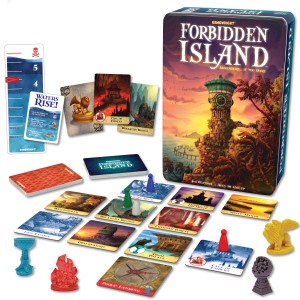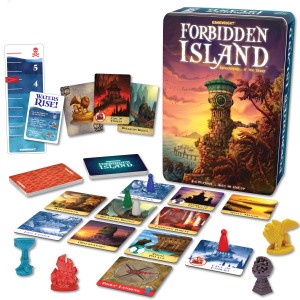Three ways learning games (aka serious games) differ from just “games”
 Last weekend, I was with friends and I introduced them to the game Forbidden Island. I figured they would enjoy it as much as me. Wrong. Wrong. Wrong.
Last weekend, I was with friends and I introduced them to the game Forbidden Island. I figured they would enjoy it as much as me. Wrong. Wrong. Wrong.
The game is a cooperative one rather than a competitive one. Players have to work together to locate hidden treasure and fly off the island before it sinks. The focus is on problem solving, strategy, and cooperation as you work together to figure out the best moves for each player to make. To me, the game is a lot of fun to play. To two of my four friends playing, the game was torture. It was “too complicated.” It had “confusing rules.” (The game is designed for players 10 and up so it cannot be THAT complicated, but you DO have to pay attention. The game has won a ton of awards and millions have played it. It’s been play-tested extensively.)
Learning games can be a terrific learning tool. They can also be a major source of shut-down in a target audience. My friends are intelligent people, but they have both told themselves stories about how they view games. That story is, “I don’t like games. I am not good at games.” Or worse, “I only like certain kinds of games…ones that do not require strategy or too much thinking.” In my experience, I run across a lot of learners who are like my friends. A game becomes fraught with risk rather than something fun that engages them.
Here are three things you really need to do when you create a learning game:
1. Make the game’s design and play experience consistent with your learning goals.
One of the decisions we made early on with Knowledge Guru was to make the game very, very easy to learn to play. You do not risk looking “stupid” because you cannot figure out the rules. You answer questions. The strategy is limited to recognizing that feedback screens are your friend. Paying attention to them helps you on subsequent paths or levels in the game. Why did we limit the strategy? Because Guru is designed as a knowledge acquisition or application game – not as a strategy or problem-solving game. Its focus is on getting players to have a pleasurable way to reinforce knowledge or to focus on how knowledge gets used in their jobs.
Competition is used as a game element, but because the game is largely played online, the competition is more abstract. We don’t have Susan trying to thump Peter in the game. We have people focusing on having the highest score or specific achievements they can celebrate. With a Legends game type – the one we recommend for live play experience – you can also set up competitions to be team-based, which is typically better than pitting one person against another person.
2. Consider the characteristics of YOUR players – not the general population.
If someone were designing a game for people like ME, they would create a high-strategy game, possibly with role-playing elements. This would NOT be the game designed for my two friends, who are distrustful of games…worried that those games will magnify their perceived intellectual flaws or personal shortcomings. For these gals – or people like them – I needed a game with very few rules, a very narrow focus, and a short playing period. Learning the game needed to take minimal time and energy.
You want to design a game that will appeal to as many members of your target population as you can. Be aware that probably NO game will appeal to every single member of your target learning group. This does not mean the player will learn nothing from playing, but he or she may not “love” the experience.
3. Recognize that set up is crucial.
A lot of novices in the learning game design arena assume that the game takes care of itself. If you say the word “game,” your learners will automatically be excited and ready to play. This is so NOT true. A certain percentage may enthused, but others will be resistant for a variety of reasons. Your set up of the game experience is crucial to successful implementation and maximum learning from the game. A few things:
- Clarify how the game play will fit into everything else they need to do in their jobs. A learning game differs from a recreational game in that players are not CHOOSING to play; they are expected to play. They view the game as a job requirement in most instances. The hope is that once they begin playing, they find the experience pleasurable…but they are not going to assume it’s pleasurable just because you use the word “game.”
- Help players understand how it benefits them; be clear about how it will help them. Examples could include a game’s ability to reduce job stress, make customer interactions easier, make a process quicker/safer/easier to do, etc.
- Acknowledge people’s efforts and performance. In Guru, we have a variety of leader boards as well as a Standings tab. It is very, very easy and transparent to see how people are doing. As an implementer, you can acknowledge effort via broadcast emails, Intranet banners, closed-circuit TV, a personal VM message, a team meeting, or a variety of other ways. This acknowledgement goes a long way toward incentivizing continued play or emphasizing the value of play.
- Consider tangible incentives – but keep them small. Handing out large prizes for game play is probably NOT a good idea because those who are lower on the score board quickly become discouraged. However, small incentives for being the first to play on a given day, for the first to hit a specific milestone, or for achieving mastery or a given topic by a specified time point can be useful acknowledgements and incentives.





